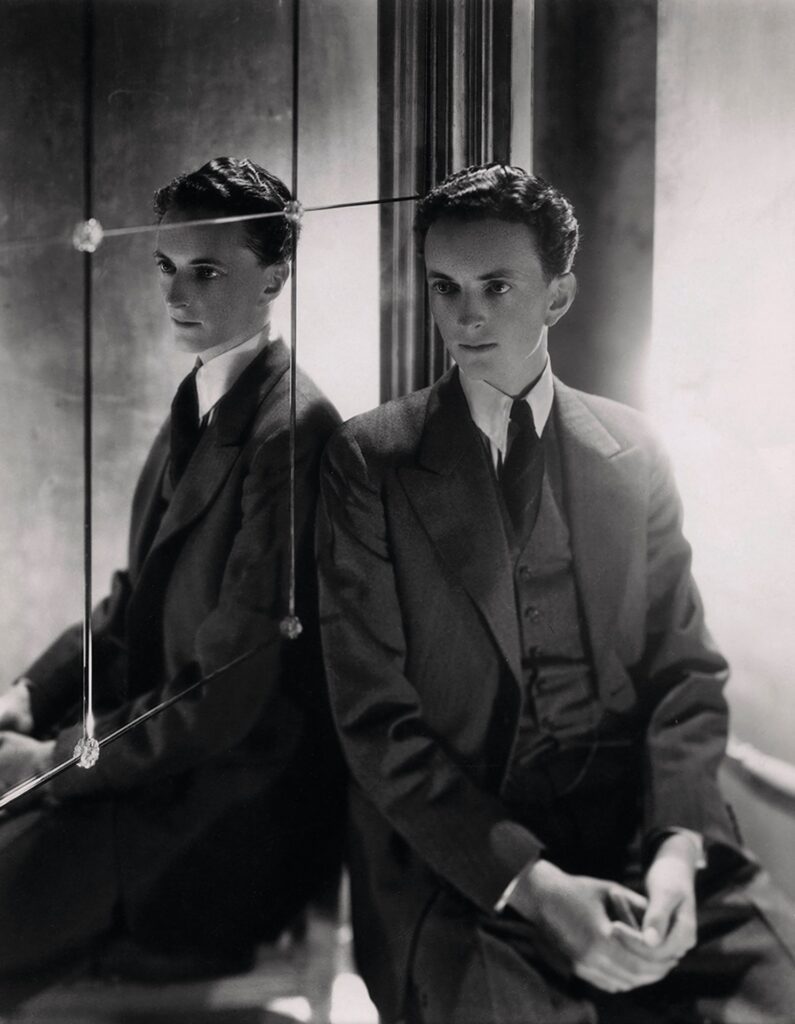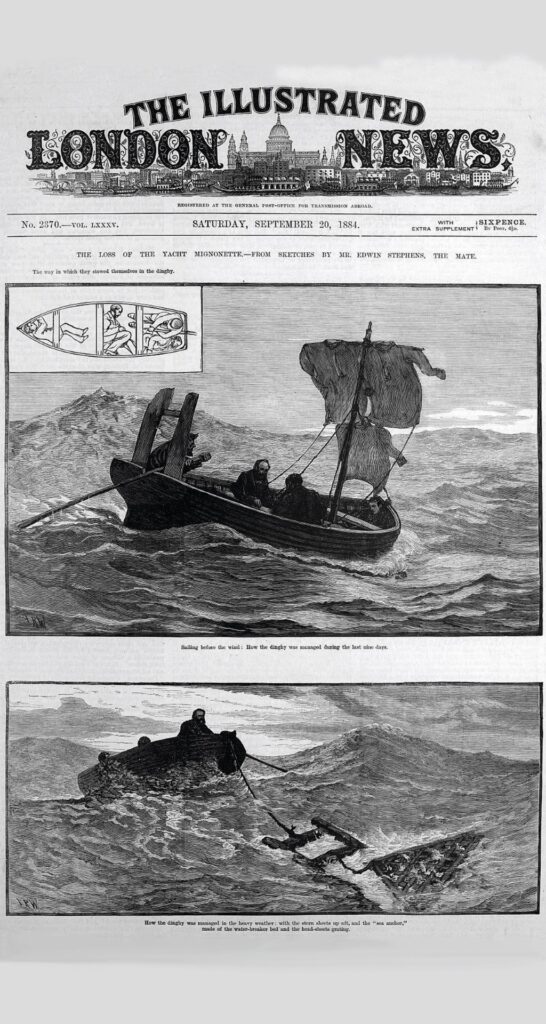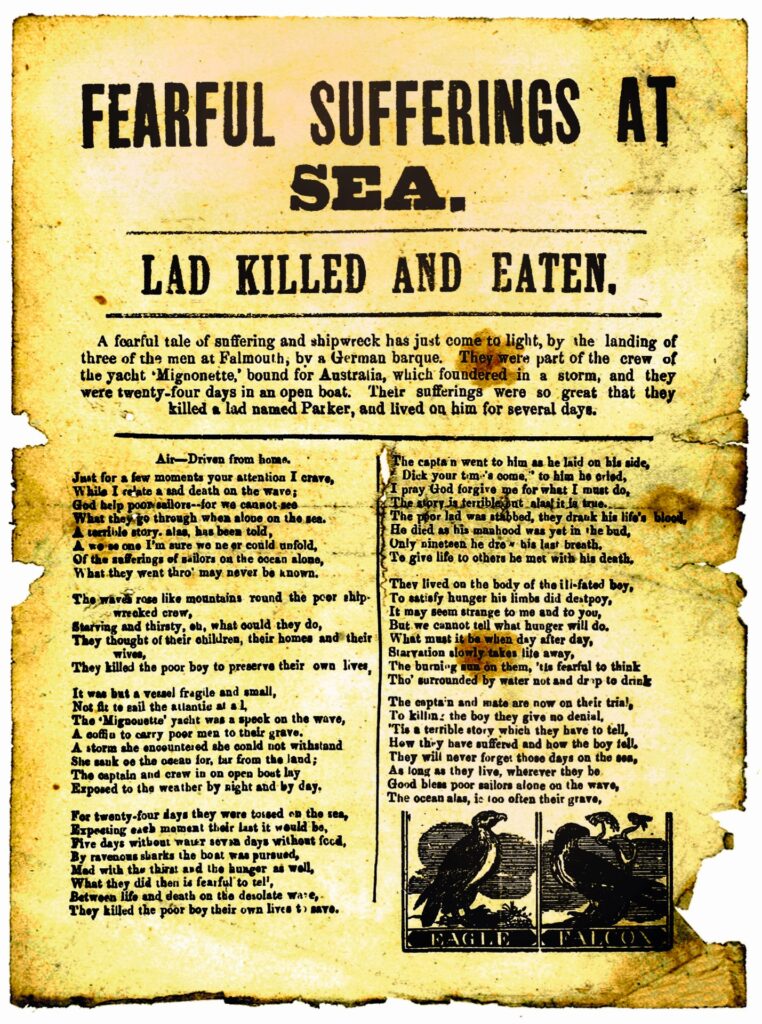Apparent coincidences form vital wholes gaping in the net of
physical causality, through which deus ex machina manifests
his volition; they are tears in the fabric of reality through which
Destiny and Fate seep through.
Arthur Koestler
Who is this? It is a man in a suit with wavy hair, standing in front of a mirror. We see him from behind, looking at himself, but his image in the mirror also shows him from behind, as if the mirror reiterates his figure as we see him, rather than reflecting it in a frontal view. The painting by the Belgian artist René Magritte is entitled La Reproduction interdite (Not to Be Reproduced). It never occurred to me to find out who the man in the picture was, nor did I surmise that he was modelled after an actual person. Or if he was—which is quite possible, given that Magritte often worked from photographs—I did not think that his identity mattered at all. Later, during my study trip to Mexico, an acquaintance offered to take me to the home of the man in the painting.
I was rather shocked to learn that he was the British poet and patron of the arts Edward James, that he had served not just as the model but the patron who commissioned the work, and that he might have even had a hand in inventing the odd title for it. Situated near the village of Xilitla in the heart of a dense subtropical forest in central Mexico, James’s private paradise, named Las Pozas (The Wells), is a strange hodgepotch of interleaving buildings and statues on the grounds of a park, which the proprietor created after 1945, and where he subsequently spent the greater part of his life until his death in 1984. By the time I visited Xilitla, in 1999, the rain forest had reclaimed the site with its wet tendrils, sticky moss, and shady ferns, rewriting the poet’s world, and has been at it ever since, relentlessly expanding, demolishing, and remodelling the set of buildings. I believe that James reckoned with the proliferation of nature, and accommodated the passing of time in his design of Las Pozas. Be that as it may, Not to Be Reproduced was painted in 1937, before James embarked on his new life in Mexico. During that year, the patron of the surrealists commissioned several paintings from Magritte, and even invited the painter to stay at his house on Wimpole Street in London for a few months. Magritte painted three canvases there, each a blown-up remake of a former painting: The Red Model, On the Threshold of Liberty, and Youth Illustrated. The remaining three pieces of the commission had to wait until he had returned to Brussels. The first, The Poetic World, also consisted of a new take on a pre-existing painting, but the other two were both original works. Moreover, both—the one we are looking at and The Pleasure Principle—are portraits of James himself. Not that the latter will be of any more help than the former if you are curious about what he looked like, since it shows a bright patch of light eclipsing the man’s head, as if he had been photographed behind a window pane or facing a mirror by someone who forgot to turn off the flash.
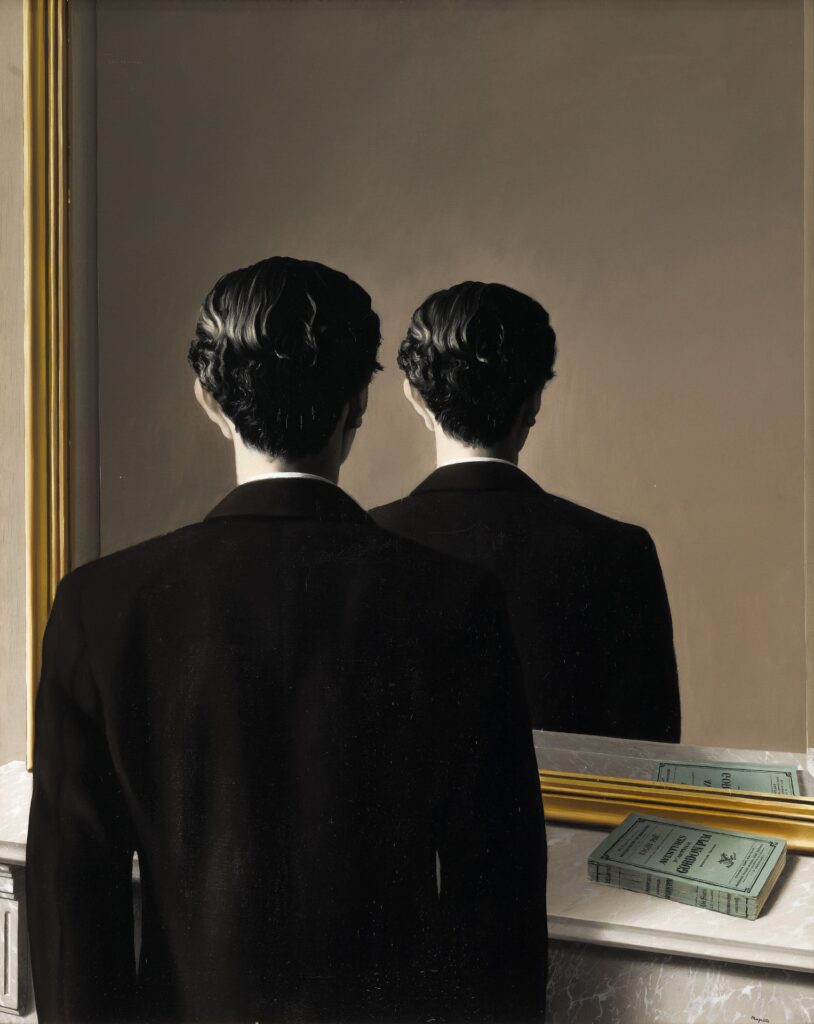
It is conceivable that the title of Not to Be Reproduced hints at a deal between James and Magritte, whereby the painter agreed never to make a copy of the painting, as was certainly the case with other works of his that James had come to own. In any case, Magritte never did remake this one, even though nearly all of his major paintings survive in several versions. If my conjecture is true, there must be a slight irony to the gesture of elevating a clause of the contract signed in London (or the verbal gentlemen’s agreement) into the title. Of course, another explanation for the absence of a copy may be that the artist was so satisfied with the painting as it was that he did not deem it necessary to subject it to a revision of any kind. Nor did he subsequently paint any more mirrors, apart from Time Transfixed, despite his previous period having teemed with the mirror motif or at least works featuring the word mirror in their title.
Perhaps Magritte felt that, in Not to Be Reproduced, he had managed to formulate something so conclusive as to obviate the need to pursue the mirror motif any longer. If this was indeed the case, we would do well to decipher his philosophy of the mirror. The purpose of art is not to represent (or, if you will, imitate) reality but to reveal ‘the other side’, an invisible, hidden world that can at best be at best but never actually seen. It seeks to profit from the tension arising in the viewer from the desire to see what he or she is prevented from seeing—in the case at hand, the face of the man with his back to the viewer. The mirror, ostensibly an object intended to show a face, here hides it from view. This is a striking reversal of the mirror as a centuries-old symbol of the representative function of art understood as a means of ‘holding up a mirror to nature’. In Magritte’s painting, the mirror embodies an admonition: you are mistaken. Your notion of artistic representation as a demonstration of reality has nothing to do with genuine art, in which the mystery of concealment overwrites the spectacle. The world cannot be reproduced.
Can Magritte’s title then be interpreted as a cri de coeur against the act of copying? Is it possible that the title questions the prerogative of art to copy, emulate, repeat, and duplicate? Or does it interrogate the relationship of the copy to that which we hold to be authentic and call real? Various philosophies of art like to label one another as being sympathetic or hostile, based on whether they see the gulf between the real and the copy as bridgeable or not. Whereas the traditional schools of thought proclaim that all visual copies are aimed at rendering reality as faithfully as possible, preferably to the point of making the copy indistinguishable from the copied object, avant-garde theorists not only deem such a degree of similitude hopeless but downright reject any project that takes it upon itself to copy reality exactly. Yet Not to Be Reproduced sets up an equation between the copy and the copied by generating a paradoxical situation. The man standing before the mirror and the one in it—the ego and the alter ego—are virtually interchangeable, and the formula would only become lopsided if another flesh-and-blood copycat joined them as a third; for instance, if Edward James in person stood behind his life-size image, or a viewer paused in front of the painting at the Boijmans Van Beuningen Museum in Rotterdam.
Are we to recognize Magritte’s painting as a precursor to the new paradigms of copying, appropriation, quotation, and multiplication favoured by contemporary art, or as an ironic musing over these theories? We might as well accept this as the solution to the riddle presented by the title, were it not for that other object, a book, in the painting. It might come across as being insignificant compared to the entirety of the composition, yet because there are so few other things in the picture—nothing, apart from the book, besides the duplicated poet, the mirror and a mantelpiece—it commands our attention. Additionally, it occupies the lower right corner of the painting, almost bracketed, where the solutions to a puzzle are usually placed on the page.
Let us lean forward to take a closer look. It is a simple paperback copy, greenish grey and tattered, of Edgar Allan Poe’s Les Aventures d’Arthur Gordon Pym, a French translation by Charles Baudelaire of The Narrative of Arthur Gordon Pym of Nantucket. I am thinking that if I could somehow figure out how the book landed on the canvas and what it is doing there, I might hit upon the secret of both the painting and its title.
Magritte is known to have been crazy about Poe, whose short story The Domain of Arnheim, to mention just one example, grabbed his imagination so forcefully that he paid tribute to it in no fewer than ten paintings. These are the works in which a wide window frame offers an Alpine vista against a foreground of eggs placed directly upon or in a nest on the window ledge, while standing proud of the remote, snow-covered ridge and its bleak glaciers is a cliff in the shape of a gigantic bird’s head.
Searching for the solution to the riddle of the book left on the mantelpiece, I leaf through my albums and revisit other paintings in which Magritte alludes to a work of literature, but I am none the wiser for it. The eerie, distant chain of association between the painting and Poe’s story conjured by it strikes me as the kind that cannot be unravelled easily, if at all. Copying of any sort is out of the question this time. The possibility of the painting being some sort of primary visual rendition of the novel can be ruled out beyond any doubt. It is not a literal replica any more than the huge egg locked up in a cage in Magritte’s Elective Affinities can be called a visual equivalent of Goethe’s novel. By the same token, the huge rose that fills a room does not really illustrate Léon Cladel’s Ompadrailles, Le Tombeau des lutteurs (Tomb of the Wrestlers); the sight of a boulder perched in delicate balance on a mountain ridge hardly brings us closer to Dashiell Hammet’s The Glass Key; Stevenson’s Treasure Island will not remind us of bird-headed plants; and even the strange mirror in Magritte’s painting Les Liaisons dangereuses (the one most akin to Not to Be Reproduced) would require an intricate chain of association to lead us to the novel by Choderlos de Laclos. The sketches for The Domain of Arnheim I have already discussed.
Magritte’s associations are not easy to unravel, nor is the significance of his titles. The only reason I mention his painting Hegel’s Holiday is to give us an idea of the complexity underlying his choice of a title. As the painter himself elucidated, ‘I […] thought that Hegel […] would have been very sensitive to this object which has two opposing functions: at the same time not to admit any water (repelling it) and to admit it (containing it). He would have been delighted, I think, or amused (as on a vacation) and I call the painting Hegel’s Holiday.’ It is hard to decide whether Magritte really meant this tortuous explanation, or simply wanted to make a fool of the American art critic Suzi Gablik, who published his words on the subject. I suspect it was the latter.
But let us return to Not to Be Reproduced. Needless to say, it did not escape my attention that the Poe book on the marble ledge is reflected ‘by the book’ in the mirror. I mean that the mirror replicates the book in the way a run-of-the-mill mirror is expected to do, not the way it deals with the man with his back to the observer. Unlike the figure of Edward James, the book is seen in a reverse reflection. Incidentally, for us Hungarians, the word fordítás means not just ‘reversal’ but also ‘translation’, and knowing the fondness James, Magritte, and the surrealists in general had for wordplay, it is impossible not to remember this polysemy.
The interplay between reversal (turning an image around) and translation (turning a text from one language into another) may be acceptable as a modicum of the solution to the riddle, yet I expect to come up with more, something more fascinating. I feel it will be worth seeking further. I decide to reread the book. When I was a child, Poe’s novel shared the same shelf in my room with novels by Verne, Defoe, Stevenson, and Hungary’s own Jókai. They were so close together that their boundaries are now blurred in my memory. At this point I recall what Jorge Luis Borges once said: ‘I believe that rereading is more important than reading, except that, of course, in order for us to reread something, we must have read it in the first place.’ As for Poe, he does his best to make sure his book is not read as a piece of fiction but as a story taken from real life and merely passed on or, if you will, reproduced, by the author. The Preface to the novel, ostensibly by A. G. Pym himself, states that ‘[Mr. Poe] proposed (finding that I would not stir in the matter) that I should allow him to draw up, in his own words, a narrative of the earlier portion of my adventures, from facts afforded by myself, publishing it in the “Southern Messenger” under the garb of fiction’. Is this the kind of quasi-reiteration that could shed light on Magritte’s strange title of Not to Be Reproduced? No, it would be too easy, too self-explanatory, let alone worthless in showing us why the type of ‘reproduction’ in question would be prohibited. So this route is more likely than not a dead end as well, but putting aside the book is the last thing on my mind. I enjoy immersing myself in a sea of adventure, so I plunge into the narrative, self-described as ‘comprising the details of a mutiny and atrocious butchery on board the American brig Grampus, on her way to the south seas, in the month of June, 1827. With an account of the recapture of the vessel by the survivors; their shipwreck and subsequent horrible sufferings from famine; their deliverance by means of the British schooner Jane Guy; the brief cruise of this latter vessel in the Antarctic Ocean; her capture, and the massacre of her crew among a group of islands in the eighty-fourth parallel of southern latitude; together with the incredible adventures and discoveries still farther south to which that distressing calamity gave rise.’
The suspenseful synopsis quoted above affords hardly more than a glimpse of the sailor’s tale of vicissitudes that follows, which serves up all the thrills and goosebumps one could wish for, from tempest and shipwreck to captivity, intrigue, plague, massacre, famine, thirst, and cannibalism—in short, episodes whose re-enactment (reproduction?) in real life is something that the enthusiastic reader should think about a hundred times, no matter how fired up by romantic passion. So now onto cannibalism, this most horrible of all horrors. I will not suggest that the sensitive reader should skip the discussion that follows, as I hope that recalling (that is, rereading) these events might bring us closer to deciphering Magritte’s painting.
We are in the geometric middle of the book, at the middle of Chapter XII. Four shipwrecked men—the narrator and three mates—are waiting to be picked up by some rescue vessel as they are tossed around on the open sea. Having long run out of food, and being on the threshold of death by starvation, they decide to eat one of those on board. The unfortunate victim who draws the short splinter from the narrator’s hand is a sixteen-year old sailor by the name of Richard Parker. May his name be remembered as the one who exchanged his life for those of the other three, even though he surely did not make that sacrifice voluntarily. If our respect for him is shaded by a touch of malice, it is only because he was the one who most viciously insisted on the gruesome idea of drawing lots. So, once again, the name is Richard Parker.
Next I leaf through a few Magritte albums while the memory of the novel, and especially the cannibalism episode, is still fresh in my mind, in the hope of hitting on something, a reproduction, that could help me make a step forward in my investigation. I find seascapes and beaches in spades, but most are too generic to bear directly on Arthur Gordon Pym. However, La Méditation, also from 1937, allows me to see a symbol of the three accidental cannibals in the candles tapering into retching bowels that wind their way ecstatically across a beach.
Poe’s novel was published in instalments by the Southern Literary Messenger in 1837, precisely one hundred years before Magritte painted that mirror over the mantelpiece. A nice and round figure, to be sure, but I am more interested in bringing up another date. Less than half a century (forty-seven years, to be exact) before Poe penned the story of Pym, the court of Falmouth in the south of England arraigned three English sailors who, along with a fourth mate, had set off on board the small yacht Mignonette from Southampton bound for Australia, but their vessel sank somewhere in the South Atlantic and they barely made it. Drifting in an escape boat, worn out by hunger and thirst, they resolved to sacrifice and consume one in the company, and this is how they survived. (Happily, I would add, if it were not an exaggeration to use that word in this context.) The 1884 incident shows a striking similarity to Poe’s story, which becomes all the more disturbing when one considers that the 17-year-old cabin-boy who ended up being eaten was also called Richard Parker. True, the name is not especially uncommon, but still! For a novel to imitate reality is nothing new, but reality imitating fiction? Curious …
Richard Parker, American seaman (ca. 1811–16 July 1827, Atlantic, Latitude 17 north by longitude 35 west, about 800 km west of Cabo Verde).
Richard Parker, British seaman (1867, Southampton–25 July 1884, Atlantic, Latitude 24 south by longitude 34 west, about 600 km east of Rio de Janeiro).
We remember, do we not, that Poe’s narrative also featured three cannibals, who partook of the flesh of their Richard Parker for four days, just as the three Englishmen subsisted for four days on their own Richard Parker. The fictive story corroborated by reality lends itself to a homework assignment in arithmetic: if 1 cabin-boy is enough for 3 sailors for 4 days, how many cabin-boys would it take to feed 6 sailors for 12 days?
Incidentally, the British seamen were rescued by a German merchant vessel on its way from South Africa to Hamburg. I only mention this because, interestingly, the ship was named Montezuma, after the Aztec king, himself reputed to be an avowed cannibal, if we are to believe the Spanish conquistadors. He is also, as it happens, alleged to have been a distant ancestor to the French painter Paul Gauguin.
Thus we have two identical stories, two identical mysteries occurring consecutively, one behind the other in time as it were, but since our failing imagination can only grasp time as a spatial experience, it cannot help but place the two episodes at a distance from one another in space as well. I wonder if the enigmatic title of the painting, Not to Be Reproduced, has anything to do with the story presented in the book we see in it, or with its being duplicated by reality. What happens here is that the usual formula of art ‘holding up a mirror to nature’ is given a twist, in that reality raises its own mirror to show us a work of literature in it. In order to make sure that the eerily identical male figures in Magritte’s painting allude to the coincidence of the two Richard Parkers, all we need to prove is that Magritte and James could have known, and indeed did know, about the fate of the second Parker.
Before I attempt such a demonstration, let me pause to pick up the thread of the Koestler connection (author of the motto of this piece). Arthur Koestler, the writer of Hungarian extraction and member of the British Royal Society of Literature, published the ‘twin story’ in the 4 May 1974 issue of the The Sunday Times, as the winner of the coincidence contest he had announced and adjudicated himself. The story of the second Parker boy eaten by his mates, substantiated by court documents, was sent in by a Nigel Parker, a collateral relative of the victim. It was then, thirty-seven years after Magritte had painted his Not to Be Reproduced, that the spooky coincidence between the two stories became tabloid news, at a time when Magritte was no longer alive and Don Eduardo, having retired to Mexico, occupied himself conversing with the birds and smelling the flowers in his garden in Xilitla. He would hardly have thought of subscribing to The Sunday Times, a paper in any case too conservative for his palate.
When Koestler advertised the coincidence contest in early 1974, he had for some time been recognized as a devout authority on paranormal phenomena, a subject he investigated at length in books such as The Case of the Midwife Toad and The Roots of Coincidence. He believed that these shocking cases were not produced by blind chance but that they obeyed some hidden law outside the scope of tedious materialism and pedantic determinism. Koestler hoped that the deep scoop of episodes served to him on a platter by the entrants to the contest would enable him to describe this enigmatic rule. As he fancied, there had to exist in the universe another force of attraction akin to gravity which pulls mutually similar things together in time and space, forming a group of parallel phenomena. In addition to the law classical philosophy calls causality, he increasingly used the notion of seriality to denote phenomena exhibiting some kind of correlation or coincidence without having a demonstrable cause and effect relationship of any kind. He mused over parallel universes and hyperspace tunnels, which he thought enabled worlds astronomically distant from one another to establish direct contact. From Einstein’s equivalence between mass and energy he inferred the consubstantiality of consciousness and matter, and he found statements he read as supporting his theories in the works of authors as diverse as the astronomer Arthur Stanley Eddington, the physicist Wolfgang Ernst Pauli, and the psychoanalyst Carl Gustav Jung. Koestler worked his way through all books relevant to the subject with extraordinary verve and admirable diligence, but somehow he remained oblivious to Poe.
Had the sad fate of the real Richard Parker not been widely publicized before 1974, when the winner of Koestler’s contest was announced, we would have every reason to ask how on earth James and Magritte could have been familiar with the story in 1937. However, the case of the second Parker was hardly unknown. Although several British papers made front-page news of the appalling incident itself, it would doubtless have been forgotten over the span of half a century. Yet the trial of the cannibals became a textbook example for precedent-based common law in the Anglophone world. It was not only mandatory reading in legal curricula, but a curiosity that acquired notoriety outside the circles of jurisprudence. Based on the verdict of the jurors, who found the defendants guilty of murder, the Queen’s Bench Division meted out the death sentence upon Captain Tom Dudley and the helmsman Edwin Stephens, because the case law of the day did not recognize ‘necessity’ as an admissible plea in a homicide trial (which the defendants submitted) unless it involved ‘justifiable self-defence’. The verdict sharply divided public opinion and triggered a sympathy demonstration of fellow sailors. The widespread indignation did not go unnoticed by Queen Victoria. Eventually, she pardoned the two men, who then spent a scant six months in forced labour before being released and emigrating to Australia. Since this denouement, British courts have exercised more tolerance in contemplating the meaning of ‘necessity’, in light of the Dudley–Stephens case. I have no way of knowing whether Magritte heard about what to many in England was a very familiar affair, but I am certain that Edward James, a graduate of the finest schools there, did. If I had any lingering doubts, those were quickly dissipated when, rummaging through the Dudley–Stephens files, I stumbled across the surname: the leading prosecutor was called Sir Henry James. As I do not know whether the two Jameses, the 1st Baron of Hereford and our own aristocrat of a poet, were related, to say nothing of the fact that the name is even more common than that of Parker. Let me instead bring up another key character in the same trial, Sir John Duke Coleridge, who held the post of Lord Chief Justice of England, the highest ranking legal dignitary in the kingdom. I must mention him not just because his authority and wisdom was badly needed during the case (his judgement in Regina v Dudley and Stephens is routinely counted among the three most important verdicts he pronounced over his career) but also because he happened to be the nephew of one of the greatest English poets, Samuel Taylor Coleridge. Yes, I am speaking of the same Coleridge whose best-known poem, The Rime of the Ancient Mariner, served as the arch-romantic wellhead that is first cited by literary historians enumerating the influences on Edgar Allan Poe as he committed his Arthur Gordon Pym to paper.
The only thing left to account for is why nobody shed light on the weird coincidence in 1884—or if someone did notice the recurrence of the name in a similar context, why it did not become an instant global sensation. Yet the explanation is a simple one: at the time Poe was virtually unknown in the Empire. The English generally considered it below their rank to pick up a book written by an American, and were left largely unmoved by the appreciative commentaries written by Dickens, Tennyson and, later, Wilde. Poe’s positive European reception began in France, owing to a decisive extent to Baudelaire’s translations, to Gustav Doré, who crowned his oeuvre by his illuminations to The Raven, and of course to Jules Verne, who conceived his novel Le Sphinx des glaces (published in English as An Antarctic Mystery) as a sort of sequel to Arthur Gordon Pym. The high-brow Brits had not come round to Poe until they realized that he had long since drawn the admiration of the French, whose opinion had always mattered a great deal to them.
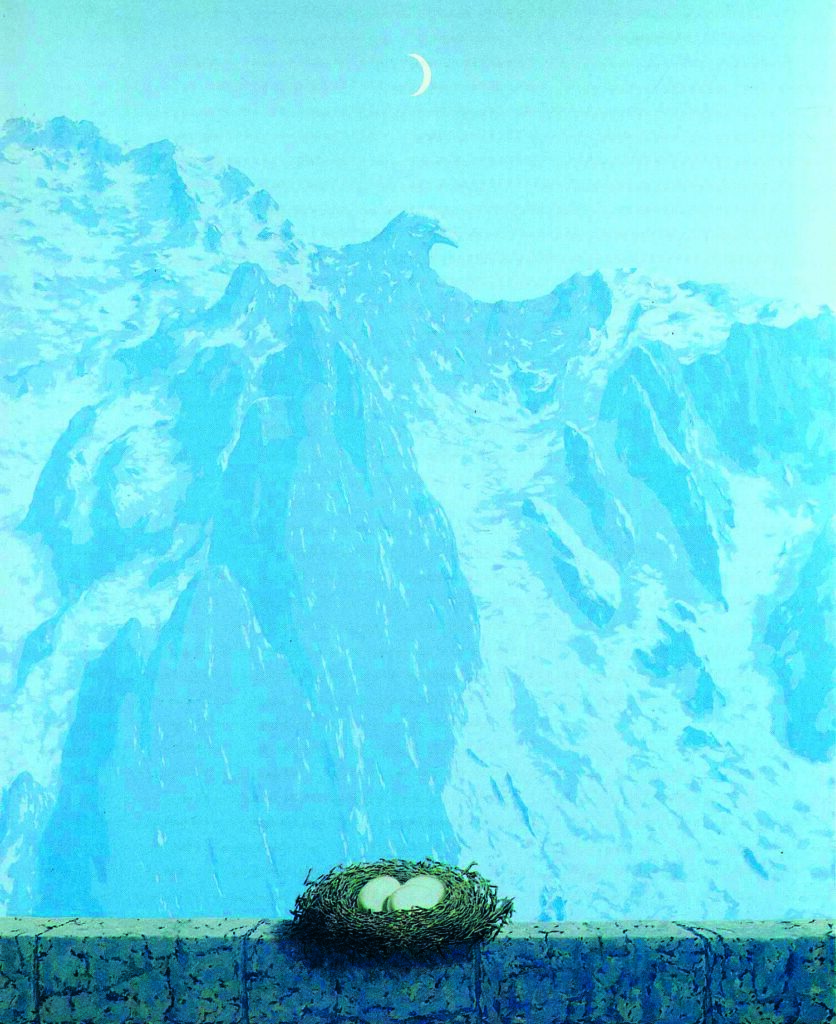
One might as well inquire why neither the creator nor the owner of Not to Be Reproduced (Magritte and James, respectively) made a song and dance about it, but we should not expect an answer from either man. Magritte was not keen on commenting on his paintings, or, for that matter, on their offbeat titles. He considered that any explanation would dispel the mystery of his images, robbing them of their very essence. He had a habit of short-changing inquisitive fans with generalities. ‘If you look at something and try to find out what it means,’ he once advised a friend, ‘you end up by seeing not the thing itself but the questions that it has raised.’ He insisted that his ‘images must be seen such as they are’. As for his patron James, it was natural for him to respect the painter’s intentions—nor would transforming a theme into a tabloid sensation have befitted the born aristocrat that he was.
One could go on to ask whether what is at stake here is one of the key creative techniques of surrealism, Magritte’s movement of choice. Perhaps not one but the key modus operandi. Many works regarded as Dadaist or surrealist were created by the method of what we may call ‘poem in a bag’, or by using pleated paper, drawing blind, or automatic painting. The artists followed the twists and turns of chance, but also anticipated them. They enabled coincidences programmed by random events, irritations, and accidents, so these works did not spring from the subjective and arbitrary decisions of the artist so much as from ‘objective chance’, to borrow a term from Breton. Only phenomena revealed by the ‘hasard objectif’, he maintained, can be void of ideology, false consciousness, and materialistic human relations. Chance also comes in handy as a tool for spiritualizing the notion of visual representation, allowing us to see how reality is overwritten by truth, truth by appearance, appearance by faith, faith by reality once again, and so on and so forth, in a cycle of eternal return courtesy of a set of mirrors accidentally (?) set up at just the right angle from one another. Chance. It was a key word in the oft-cited simile invented by Comte de Lautréamont, widely considered a forerunner of surrealism, who likened the beauty of a boy to ‘the chance meeting on a dissecting-table of a sewing-machine and an umbrella’. Indeed, the most famous book Magritte ever illustrated was Lautréamont’s The Songs of Maldoror. He must have accepted the commission in 1948 with more than a hint of satisfaction, after his great rival Dalí had first had that honour fourteen years previously.
Yes, I am speaking of the Salvador Dalí who became the second favourite protégé of James after Magritte and—bingo!—promptly allowed the cannibal motif to sneak into his works, including The Nostalgia of the Cannibal (1933), Autumnal Cannibalism (1936), and Cannibalism of the Objects (1937). He supplemented these paintings by a quasi-explanatory essay he more fittingly called a ‘paranoiac-critical interpretation’, entitled The Tragic Myth of the Angelus of Millet. Even though the piece remained unpublished until 1963, Dalí had finished writing it by 1936, the year when the Spanish Civil war broke out and Magritte painted his Not to Be Reproduced. Actually, the manuscript got lost for a while during those chaotic days, although the famously long-winded Dalí (the perfect antithesis to Magritte’s introverted mien) never missed an opportunity to babble about his pet theory: the motif of cannibalism hidden in Millet’s Angelus. We might find it difficult to imagine a more peaceful painting, a deeper calm than the view of two peasants lost in quiet prayer during a break from picking potatoes, against a backdrop of sunset over a vast open land, but Dalí, as he wrote, ‘was most upset by it … [It] suddenly became for me the most troubling of pictorial works, the most enigmatic, the most dense, the richest in unconscious thoughts that had ever existed’, which emanated for him the sense of a maddening drama. Dalí conjectures that the figures of the standing woman and the man facing her and holding his hat in his hands in front of him (in order to hide his erection, according to Dalí) enact the tense moment before coitus. From the posture of the woman he infers cannibalism, the subject of an obsession he developed while studying the love life of the praying mantis, the female of the species of which are known to devour the male during mating, without for a second interrupting the act. They start with the male’s brain and proceed to eat their way through methodically, all the while making sure—as if to render the consummation more chilling or, perhaps, more exalted—that the males continue copulating with them to the bitter end, even with their heads missing and most of their bodies chewed off. ‘I have always imagined that, during an amorous intercourse, I would succumb to the fate of the male praying mantis myself’, he once confessed to James, whom he also immortalized in one of his paintings, and in 1937 of all years. James is seen wearing a white shirt, standing with his hands on his hips. He is but a distant supporting actor in Dalí’s Swans Reflecting Elephants, but clearly recognizable nonetheless. Certainly more clearly than in Magritte’s Not to Be Reproduced.
Translated by Péter Balikó Lengyel

